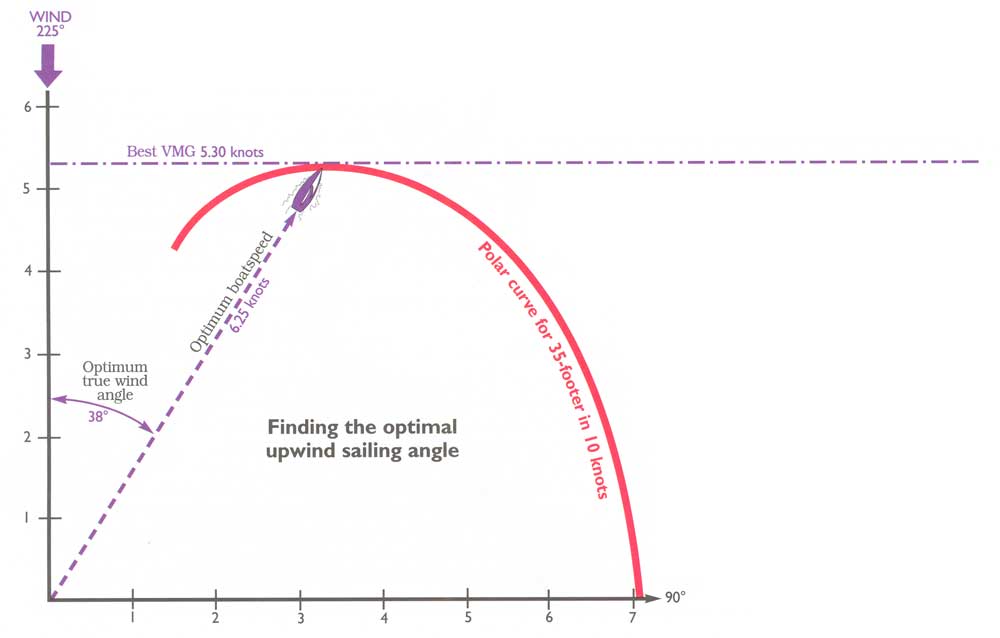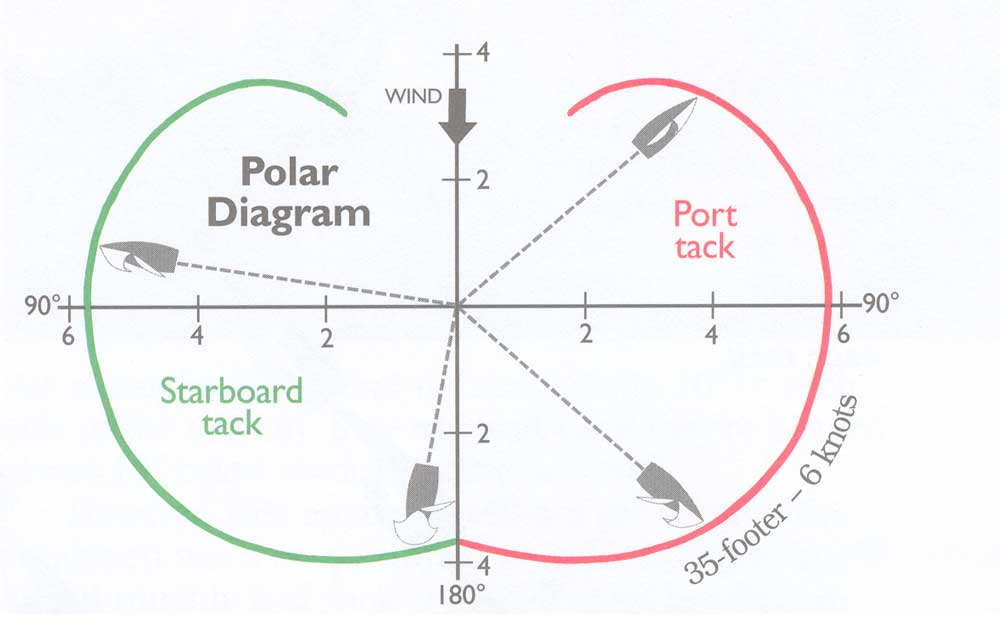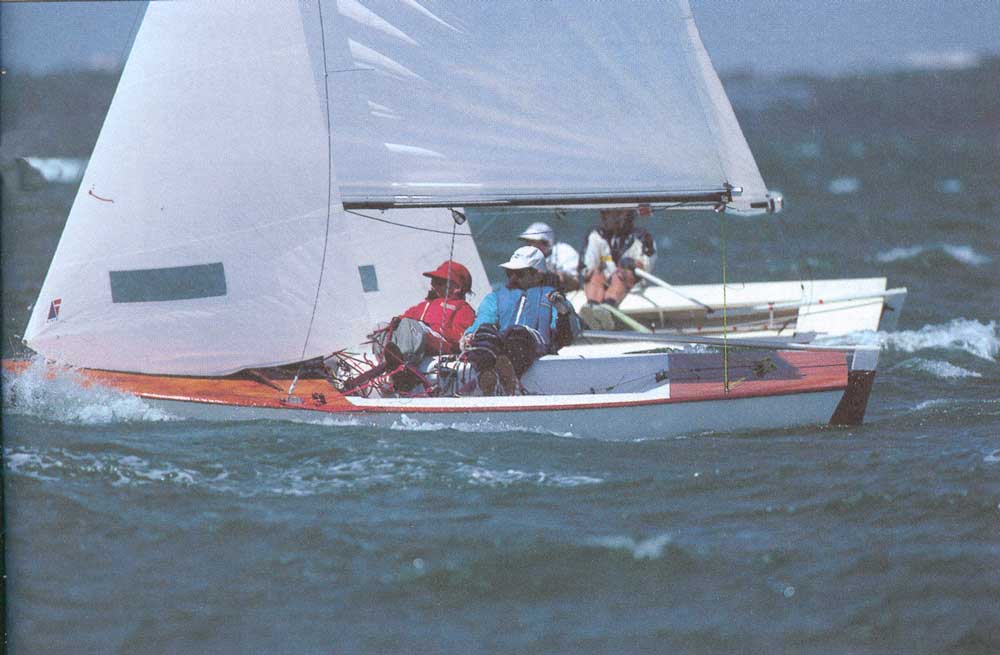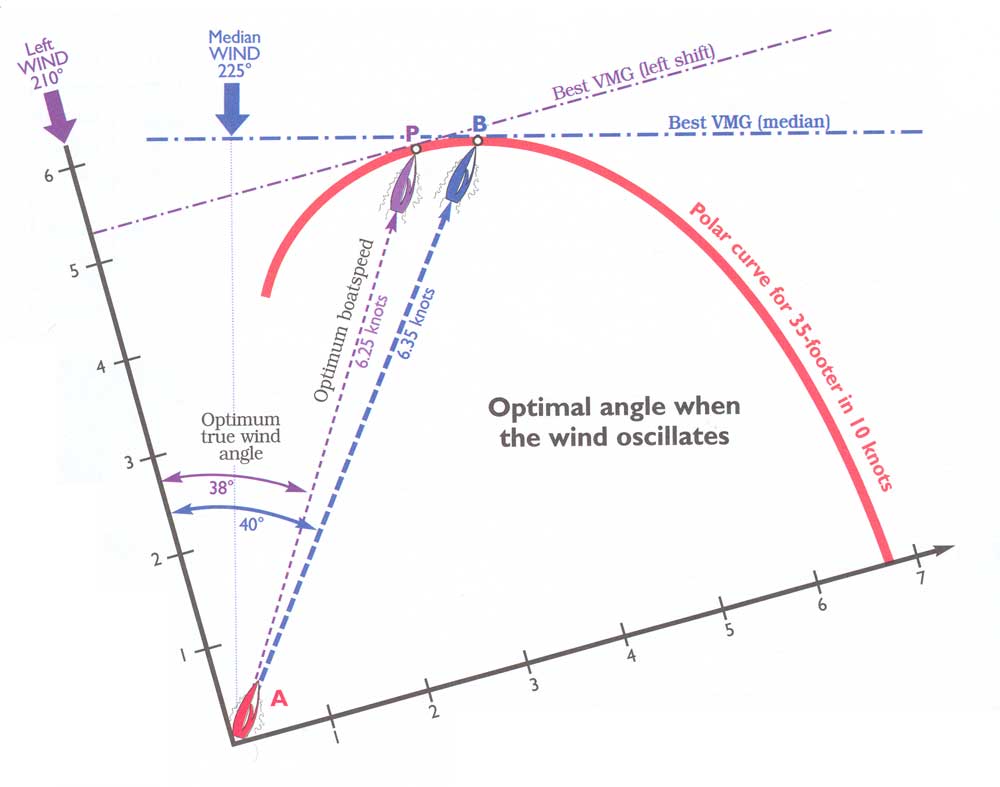by David Dellenbaugh
When the wind direction is steady, the fastest way to reach the windward mark is simply to get your boat in the “groove” and sail for maximum upwind VMG. But when the wind is oscillating, that’s a horse of a different color.
The bottom line is that whenever you’re on a lift, you can improve your upwind
performance by sailing a little faster and lower than normal. Here’s why: In a
steady breeze, your goal is to maximize your performance in the existing wind
direction. After all, the wind you feel at any moment is the same wind you will
have all the way up the beat, so you want to climb up the ladder rungs in this
direction.
 |
| Every boat has a choice of how to sail upwind. You can go
high and slow, low and fast, or any other combination along your “polar
curve”. For every wind velocity, however, there is usually one boatspeed
(and a corresponding wind angle) that will give you your best
velocity-made-good to windward. This “target” speed is the point at which the boat’s polar curve intersects with the highest ladder rung (a line drawn perpendicular to the wind direction). By aiming for this point, you will get to a higher ladder rung than you would with any other combination of speed and angle. In the example at left, this 35-footer’s target speed in 10 knots of wind is 6.25 knots at a true wind angle of 38 degrees. In most conditions you should aim for your upwind target all the time. However, there are a few times when you should sail faster or slower, for either tactical or strategic reasons. As we will see on the next page, sailing on a lift in an oscillating breeze is one of these. |
However, when the wind direction is oscillating you have a different goal - to
maximize your performance for the average wind direction you will have for the
entire beat. Your main priority, therefore, is to climb up the ladder rungs of
the median breeze, not the ladder rungs of the left or right oscillations.
In order to do this, you should sail a little faster than normal when you’re
lifted (see the diagrams for a geometric “proof”). How much faster? That is hard
to say without an onboard computer, but generally it is just a little bit.
Perhaps it means sailing with your windward telltales flowing straight back
rather than lifting. Certainly you don’t want to pinch, or sail with your sheets
eased very much.
Sailing faster achieves two goals: First, you get maximum performance relative
to the average wind direction; and second, you sail faster toward the direction
of the next expected shift. The more you are lifted (relative to the median),
the faster you should sail. As you get headed toward the median, slow down and
head up slightly until you are sailing at your normal speed and angle.
When you should not sail fast and low on a lift
 |
| For any boat and wind velocity, we can create a polar diagram to describe that boat’s performance. This plot, generally shaped like a cross between a lima and kidney bean, shows how fast this boat will go on all angles of sail. You can also use this tool to figure out the optimal angles and speeds for this boat to sail on beats and runs. |
There are certain times when, even though you are lifted, you should sail your
normal upwind angle (or even pinch a little bit). These include:
Coming off the starting line - If you are lifted at the start, it would be good
in theory to sail a little fast. But the reality is you may actually have to
pinch a bit in order to hold your lane. At this point the ability to keep
sailing the lift in clear air is more important than footing to the next shift.
There’s a puff or more lift to windward - Sometimes sailing lower will take you
out of the lift or away from better pressure. If it’s possible to sail higher
into the puff, it may be better to pinch or sail your normal angle until you are
confident that you’re up into the better breeze.
The wind will not shift again before the mark - If you are nearing the windward
mark and you don’t expect another oscillation before you reach it, there’s no
reason to sail faster than normal (because there’s no shift to sail toward).
Instead, sail your optimal VMG angle for the wind you have.
 |
You should sail fast on runs, too
When you are sailing down a run in oscillating shifts, you will get to the
leeward mark faster by using the same strategy. In fact, the potential gains are
even greater on runs because you have a much wider variation in headings and
speeds.
Instead of sailing lower and faster on the lifts, however, on a run you should
sail higher and faster on the headers. By sailing higher and faster, you can
optimize your VMG to leeward relative to the median wind direction. You will
also be sailing away from the next shift faster (which usually is your goal on a
shifty run).
 |
| When the wind is steady, it’s pretty easy to pick your
optimal upwind speed and angle. You just aim for the spot where your polar
curve intersects the highest ladder rung. But when the wind is oscillating, this choice is not so clear. In the diagram shown here, the boat (A) gets a 15 degree lift on port tack (i.e. the wind shifts 15 degrees to the left of median). If A sails her optimal upwind speed in this shift, she will end up at position P. This speed and angle give her the best VMG possible relative to the left shift in which she is sailing. However, this is not her goal. Boat A really wants to maximize her VMG in the direction of the median (average) wind. The best way to do this is by sailing slightly lower and faster so she ends up at position B. This optimizes her VMG toward the median wind direction and also gets her to the next shift sooner. |
Whether you are going upwind or downwind, the key to using this technique is
knowing the median wind direction - otherwise you won’t be sure if you’re lifted
or headed. Also, don’t get too scared if other boats look like they’re gaining
while you are sailing fast. Once the next shift comes in you’ll be all set.
Dave publishes the newsletter Speed & Smarts. For a subscription call:
800-356-2200 or go to: www.speedandsmarts.com